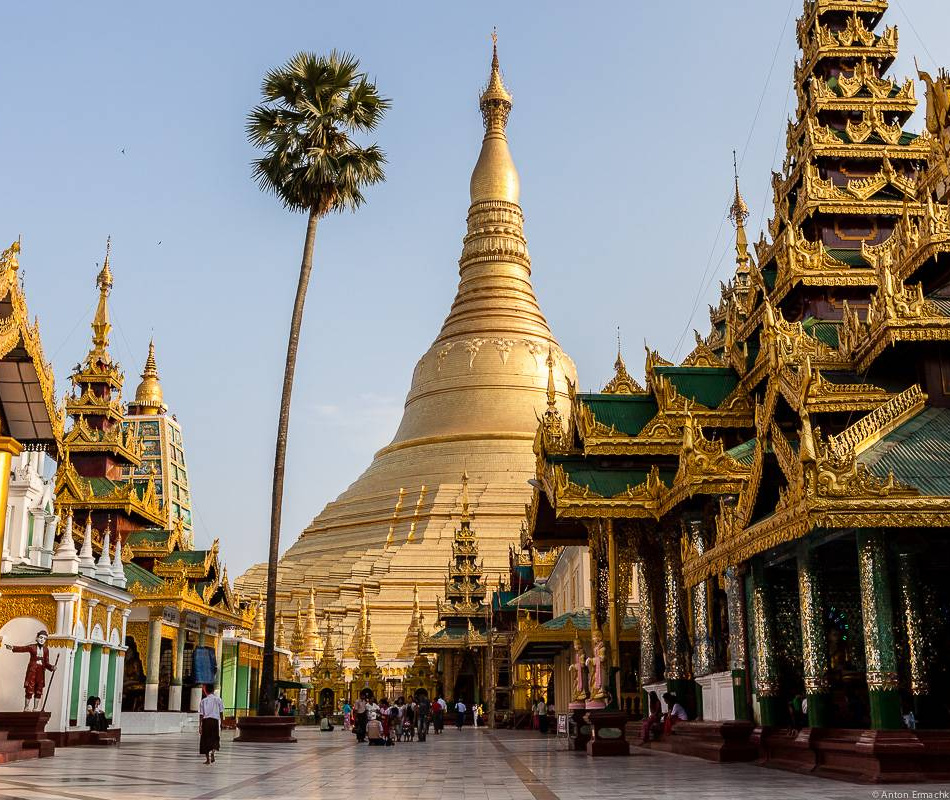Myanmar (Burma) is one of the few places on earth where time seems to have stopped. This is a country living in the past, not knowing modern technological upheavals. A trip to Burma will be a kind of journey into the depths of centuries...
Religion has always occupied and occupies a very important place in the public life of the country. Numerous military regimes (and since 1962 Myanmar has been under the military dictate of the State Council for Peace and Development, a real military junta) were forced to include religious postulates in their political programs. In every settlement, even in tiny mountain villages, there is its own temple or monastery, where every Burmese boy spends a certain period of time studying religious postulates and the church language "Pali".
Coming to Burma is not enough. You need to know how to penetrate into its very heart. The best way to do this is to take a trip on the ship "Road to Mandalay", which will take you... into ancient times. You will visit the ancient capital of Rangoon, see the famous Shwedagon Pagoda - a Buddhist temple in the form of a multi-tiered tower, visit the abandoned city of Bagan pagodas and much more. Burma is called the country of a thousand pagodas - their stepped silhouettes will accompany you throughout the journey. The legendary Irrawaddy River, the main life artery of Burma, will lead you to the final destination of the journey - the city of Mandalay, sung by Kipling.
…The traveler will forever imprint in his heart the image of a Buddhist monk in scarlet robes, the soaring silhouettes of ancient Buddhist temples and pagodas, and a city where the main mode of transport is an ox cart.
From the board of the Road to Mandalay, Burma will open up to you in all its grandeur. Comfortably located on the upper deck with a glass of cocktail, you will be able to observe the leisurely flow of life in this ancient country that has managed to preserve its youth…
The climate is tropical monsoon, in the south of the country - subequatorial.
The average temperatures in March and April (the hottest months) are from +30 C to +32 C, in January - +13 C in the north, from +20 C to +25 C in the south. The year in Myanmar is divided into three seasons, depending on the influence of the monsoons: cool (November-February, +20-25 C), hot (March-May, +30-32 C) and rainy (June-October).
Precipitation ranges from 500 mm. per year on the plain and up to 3500 mm. in the mountains. Dust storms are common during the cool season.
Yangon is one of the most unusual cities in the region. The huge city is full of trees and lawns, which practically merge with the surrounding jungle, thereby radically differing from the urbanized capitals of other Asian countries.
Bagan is one of the most interesting historical cities in Asia. Founded in the 9th century on the banks of the Irrawaddy as the capital of the Burmese Empire, the "city of pagodas and temples" was destroyed by the troops of Khan Kublai in 1287 and was never rebuilt. This is one of the most amazing archaeological sites in the world - about 5 thousand perfectly preserved temples, stupas and pagodas are concentrated here on an area of about 42 square kilometers, testifying to the greatness of the city in former times (at its peak, there were about 13 thousand religious buildings here). The most famous building in the city is the "golden pagoda" Shwezigon, built in 1057 by King Anawrahta, the founder of the royal dynasty of Myanmar.
Mandalay is the second largest city in the country and its last ancient capital. It has one of the most favorable climates in the country, which, coupled with a huge number of attractions, attracts thousands of tourists.
Travel around the country is limited. There is a special map for foreigners, which indicates areas and cities where entry is prohibited. A number of places can only be visited under the supervision of a travel agency and on a certain type of transport. Crime in the country is extremely low, the police strictly suppress any attempts to engage in begging or speculation. Theft and pickpocketing are also rare, but recently the rates of these types of crimes have been slowly but surely growing.
It is forbidden to photograph military (and military) and strategic facilities. Photography in temples and museums is prohibited or an additional fee is charged for it. The locals themselves are usually happy to pose, but they really do not like it when they are photographed on the sly. When entering the territory of Buddhist temples, you must take off not only your shoes, but often your socks as well.
The level of medical care is relatively low, health care institutions are located only in large cities and towns.
The territory of Myanmar is unfavorable for many diseases, which must be taken into account when planning a trip. A certificate of vaccination against yellow fever is required from all travelers arriving in the country from infected areas. Malaria prophylaxis is recommended, the risk of contracting which exists in areas below 1000 m above sea level (Karen, Chin, Kachin, Kayah, Mon, Shan and Rakhine, in Bago and the capital).
Vaccinations against hepatitis A, B and E, cholera, tetanus and polio are recommended. Do not drink tap water or water from natural sources. Edible ice prepared on the street is also considered potentially dangerous. Only boiled or bottled water (in industrial packaging), thoroughly washed and peeled vegetables and fruits should be consumed.
Dairy products are not pasteurized and are considered potentially dangerous to health. Meat, fish and seafood should be consumed only thoroughly fried or heat-treated. Eating pork, green salads and products based on vegetable oil mayonnaise can be risky.

